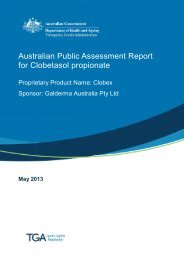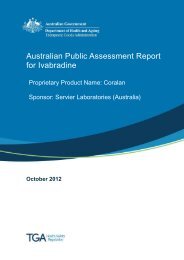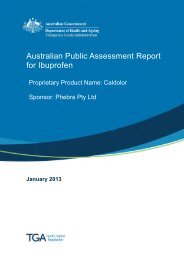CHMP position statement on Creutzfeldt-Jakob disease and plasma ...
CHMP position statement on Creutzfeldt-Jakob disease and plasma ...
CHMP position statement on Creutzfeldt-Jakob disease and plasma ...
You also want an ePaper? Increase the reach of your titles
YUMPU automatically turns print PDFs into web optimized ePapers that Google loves.
This is the sec<strong>on</strong>d revisi<strong>on</strong> of the CPMP a Positi<strong>on</strong> Statement <strong>on</strong> “<strong>Creutzfeldt</strong>-<strong>Jakob</strong> <strong>disease</strong> <strong>and</strong> <strong>plasma</strong>derived<br />
<strong>and</strong> urine-derived medicinal products” published in February 2003 (EMEA/CPMP/BWP/2879/02)<br />
<strong>and</strong> revised in June 2004 (EMEA/CPMP/BWP/2879/02 rev 1.) <strong>and</strong> June 2011<br />
(EMA/<str<strong>on</strong>g>CHMP</str<strong>on</strong>g>/BWP/303353/2010), which replaced the CPMP Positi<strong>on</strong> Statement <strong>on</strong> “New variant CJD<br />
<strong>and</strong> <strong>plasma</strong>-derived medicinal products” (CPMP/201/98) issued in February 1998.<br />
Summary<br />
Cumulative epidemiological evidence does not support transmissi<strong>on</strong> of sporadic, genetic <strong>and</strong> iatrogenic<br />
<strong>Creutzfeldt</strong>-<strong>Jakob</strong> <strong>disease</strong> (CJD) by <strong>plasma</strong>-derived medicinal products. There is no change to the<br />
previous <str<strong>on</strong>g>CHMP</str<strong>on</strong>g> <str<strong>on</strong>g>positi<strong>on</strong></str<strong>on</strong>g> that recall of <strong>plasma</strong>-derived medicinal products is not justified where a d<strong>on</strong>or<br />
is later c<strong>on</strong>firmed as having sporadic, genetic or iatrogenic CJD.<br />
Variant CJD (vCJD) is an emerging <strong>disease</strong> <strong>and</strong> the eventual number of cases of the <strong>disease</strong> is<br />
uncertain. There is a wider distributi<strong>on</strong> <strong>and</strong> higher level of infectivity/abnormal pri<strong>on</strong> protein in<br />
peripheral tissues than is seen with sporadic CJD. Four instances of apparent iatrogenic vCJD infecti<strong>on</strong><br />
by blood transfusi<strong>on</strong> in man in the UK provide str<strong>on</strong>g evidence that vCJD is transmissible through blood<br />
transfusi<strong>on</strong>. In 2009, abnormal pri<strong>on</strong> protein was detected in a haemophilia A patient who received<br />
intermediate purity FVIII prepared from pooled <strong>plasma</strong> sourced in the UK before 1998.<br />
Residence in the UK is a recognised risk factor for vCJD <strong>and</strong> has led to the UK deciding to no l<strong>on</strong>ger<br />
fracti<strong>on</strong>ate from UK <strong>plasma</strong>. It is c<strong>on</strong>sistent with this decisi<strong>on</strong> to exclude d<strong>on</strong>ors who have spent l<strong>on</strong>g<br />
periods in the UK during the risk period from d<strong>on</strong>ating blood/<strong>plasma</strong> for fracti<strong>on</strong>ati<strong>on</strong>. It is<br />
recommended that d<strong>on</strong>ors who have spent a cumulative period of 1 year or more in the UK between<br />
the beginning of 1980 <strong>and</strong> the end of 1996 are excluded from d<strong>on</strong>ating blood/<strong>plasma</strong> for fracti<strong>on</strong>ati<strong>on</strong>.<br />
There is no recommendati<strong>on</strong> to recall batches if informati<strong>on</strong> that would have excluded a d<strong>on</strong>or based<br />
<strong>on</strong> his/her stay in the UK becomes available post-d<strong>on</strong>ati<strong>on</strong>.<br />
Available data indicate that the manufacturing processes for <strong>plasma</strong>-derived medicinal products would<br />
reduce vCJD infectivity if it were present in human <strong>plasma</strong>. Manufacturers are required to estimate the<br />
potential of their specific manufacturing processes to reduce infectivity using a step-wise approach. It<br />
is recommended that manufacturers c<strong>on</strong>sult the relevant competent authorities at each of the<br />
milest<strong>on</strong>es in this estimati<strong>on</strong>. <str<strong>on</strong>g>CHMP</str<strong>on</strong>g> <strong>and</strong> its Biotechnology Working Party (BWP) will keep progress with<br />
these recommendati<strong>on</strong>s <strong>and</strong> the acti<strong>on</strong>s to be taken under review.<br />
In support of this recommendati<strong>on</strong>, <str<strong>on</strong>g>CHMP</str<strong>on</strong>g> <strong>and</strong> BWP, with the involvement of external experts, have<br />
developed guidance <strong>on</strong> how to investigate manufacturing processes with regard to vCJD risk <strong>and</strong> <str<strong>on</strong>g>CHMP</str<strong>on</strong>g><br />
<strong>and</strong> BWP are available to discuss issues that might arise.<br />
The rati<strong>on</strong>ale for this <str<strong>on</strong>g>positi<strong>on</strong></str<strong>on</strong>g> is that if, in the future, further cases of vCJD occur in countries collecting<br />
blood <strong>and</strong> <strong>plasma</strong> for the manufacture of <strong>plasma</strong>-derived medicinal products, a process previously<br />
shown to be able to reduce TSE infectivity will provide reassurance <strong>on</strong> the safety of past products, <strong>and</strong><br />
could help to justify c<strong>on</strong>tinuing fracti<strong>on</strong>ati<strong>on</strong>.<br />
Low levels of infectious TSE agents have been detected in the urine of scrapie-infected rodents <strong>and</strong> in<br />
the urine of deer with Chr<strong>on</strong>ic Wasting Disease. However, there is at present no epidemiological<br />
evidence of CJD or vCJD transmissi<strong>on</strong> by urine derived medicinal products. A general review of<br />
manufacturing processes for urine-derived medicinal products indicates that it is feasible to apply<br />
d<strong>on</strong>or selecti<strong>on</strong> criteria when a product is derived from a relatively small <strong>and</strong> well-defined d<strong>on</strong>or<br />
a In May 2004 there was a change in the name of the EMA’s scientific committee for human medicines from CPMP to <str<strong>on</strong>g>CHMP</str<strong>on</strong>g>.<br />
3/26
















